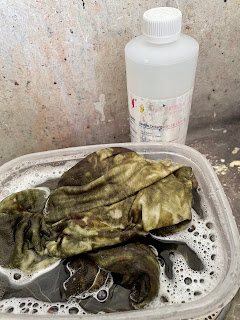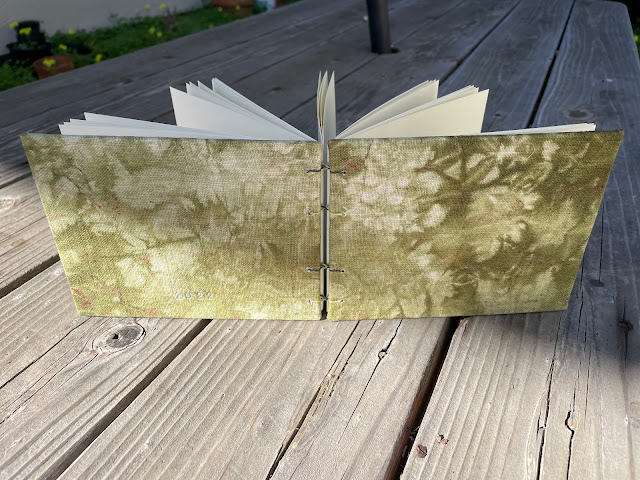After much exploring, I've found I am happy with a spontaneous kind of dyeing process that uses little water and produces big results. Okay, it still uses plenty of water, but less water than tub dyeing. You still need access to a laundry sink and hot water. By fitting a crumpled cloth into a small tub I can get a semblance of tie-dye without the ties; the pattern leans more towards flowers than fireworks. I call it crumple dye, but I think most call it "low immersion." I recently dyed a shirt for a friend and documented the recipe as I went along. I also dyed some linen and used it to cover a handmade book for a gift (hint: for book covers you don't have to back the linen with paper, and you lightly apply the glue to the boards).
Tools: plastic spatula; 48 oz plastic (yogurt) container; two 48 oz 64 oz (8 cup) food storage containers that you won't be using again for food; one smaller plastic container for pasting up the dye; 1/4 and 1/2 cup measuring cups and 1 teaspoon measure dedicated to art or that you won't be using again for food; dishwashing gloves or other plastic gloves to protect your hands (I use two: one pair on the clean cloth and one for when I am working with the dye and dyed cloth); vinyl tablecloth to protect your work surface
Materials: one pre-washed Hanes Beefy T-shirt (or other all-cotton shirt); powdered dye (I use cold-water Procion dye); soda ash fixer; textile detergent; plain table salt (although iodized will also work as it is a trace mineral and doesn't seem to interfere with the colors)
You can buy all of the materials from Dharma Trading. The beefy white t-shirts are high quality and quite inexpensive.
It does make a difference which dye batch you get, and it is worth testing first if a particular color is important to your project or if you have something you need to match. And each color will behave uniquely. Check Dharma's instructions, particularly for the very dark blues, blacks, and purples.




















Comments
Nice results